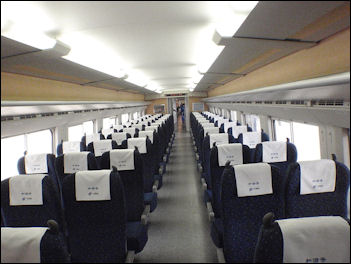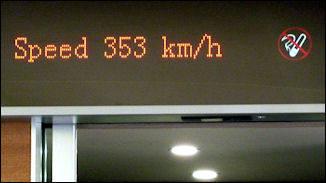PROBLEMS WITH CHINA’S HIGH-SPEED TRAINS
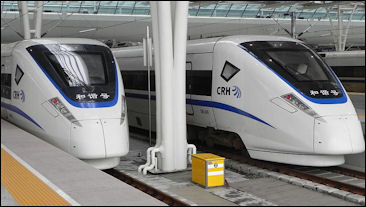
Rapid growth of China's high-speed train system has not been without problems. According to CNN: While centralized state funding, planning and approval allows China to avoid the endless legal wrangles that have bedeviled projects in Europe and the United States for decades, the flip side is that new lines pay little heed to existing communities along their route. China's high-speed growing pains also contributed to the tragic Wenzhou collision in July 2011, when two trains collided on a viaduct and derailed, sending four coaches to the floor below, killing 40 passengers and injuring almost 200 others. Public confidence in high-speed rail was severely shaken by the accident, resulting in a blanket speed reduction and the suspension of construction work on new lines pending an official investigation. However, no major incidents have been reported in the decade since and passenger numbers have risen exponentially as the network has expanded. [Source: Ben Jones, CNN, February 9, 2022]
In March 2012 AP reported: Since the Wenzhou crash, there have been reports of problems with brakes, signaling systems and faulty construction. In one case the Railways Ministry ordered almost all of a $260 million railway line in northeastern China redone after finding contractors had farmed the work out to unqualified construction companies that filled railway bridges' foundations with rocks and sand instead of concrete. [Source: Elaine Kurtenbach, AP, March 12, 2012]
Engineers working on some projects have complained of problems with contractors using inferior concrete or inadequate steel support bars. A report by the state-run magazine Time Weekly reported allegations that builders on another section of the same Wuhan-Yichang line may have compromised safety by substituting soil for rocks in the railway bed. In an interview with Xinhua, Huang Qiang, chief researcher with the China Academy of Railway Sciences, said Beijing is continuing a safety overhaul of high-speed railways that includes development and improvement of signaling equipment, train maintenance and protection against lightning and earthquakes. "China's high-speed railway development has been aggressive in previous years, in which some important links were missed," Xinhua quoted Huang as saying.
Keith Bradsher wrote in New York Times: Debt to finance the construction reached nearly $640 billion in 2012, making it one of the most visible reasons total debt has been surging as a share of economic output in China, and is approaching levels in the West.Each passenger car taken off the older, slower rail lines makes room for three freight cars because passenger trains have to move so quickly that they force freight trains to stop frequently. But although the high-speed trains have played a big role in allowing sharp increases in freight shipments, the Ministry of Railways has not yet figured out a way to charge large freight shippers, many of them politically influential state-owned enterprises, for part of the cost of the high-speed lines, which haul only passengers. The high-speed trains are also considerably more expensive than the heavily subsidized older passenger trains. A second-class seat on the new bullet trains from Beijing to Guangzhou costs 865 renminbi ($139) one way, compared with 426 renminbi ($68) for the cheapest bunk on one of the older trains, which also have narrow, uncomfortable seats for as little as 251 renminbi ($40).[Source: Keith Bradsher, New York Times, December 26, 2012]
Articles on TRANSPORTATION IN CHINA factsanddetails.com ; TRAINS IN CHINA: HISTORY, TRAIN LIFE, NEW LINES factsanddetails.com CHINA’S RAILWAY MINISTRY: ITS AMBITIOUS RAIL NETWORK, LIU ZHIJUN AND CORRUPTION factsanddetails.com ; HIGH-SPEED TRAINS IN CHINA factsanddetails.com ; WENZHOU HIGH SPEED TRAIN CRASH IN 2011 factsanddetails.com ; FALLOUT OF THE WENZHOU HIGH-SPEED TRAIN CRASH factsanddetails.com
RECOMMENDED BOOKS: “China's High-Speed Rail Development” by Martha Lawrence, Richard Bullock, et al. | Jun 30, 2019 Amazon.com; “Handbook on Transport and Urban Transformation in China” by Chia-Lin Chen, Haixiao Pan, et al. Amazon.com; “China's Great Train: Beijing's Drive West and the Campaign to Remake Tibet” by Abrahm Lustgarten Amazon.com; “Taking the Train to Tibet” by Chen Yang | Amazon.com; “Riding the Iron Rooster: By Train Through China” by Paul Theroux Amazon.com; “The Last Steam Railways: Volume 1: The People's Republic of China” by Robert D. Turner Amazon.com; “English-Chinese and Chinese-English Glossary of Transportation Terms: Highways and Railroads” by Rongfang (Rachel) Liu and Eva Lerner-Lam Amazon.com; Lonely Planet China" 16 Amazon.com
High Costs of China’s High-Speed Railways
In June 2011 AP reported: China's multibillion-dollar railway plan "has provoked complaints that it is too expensive for a country where millions of people still live in poverty. Critics say railway officials have diverted too much money to high-speed rail and should be expanding lower-cost traditional rail. The replacement of slower lines with more expensive high-speed trains has prompted complaints from passengers reluctant to pay higher fares, especially on shorter routes. [Source: AP, June 27, 2011]
Keith B. Richburg wrote in the Washington Post, “With the latest revelations, the shining new emblem of China’s modernization looks more like an example of many of the country’s interlinking problems: top-level corruption, concerns about construction quality and a lack of public input into the planning of large-scale projects. Questions have also arisen about whether costs and public needs are too often overlooked as the leadership pursues grandiose projects, which some critics say are for vanity or to engender national pride but which are also seen as an effort to pump up growth through massive public works spending.The Finance Ministry said last week that the Railways Ministry continued to lose money in the first quarter of this year. The ministry’s debt stands at $276 billion, almost all borrowed from Chinese banks. [Source: Keith B. Richburg, Washington Post April 23, 2011]
“They’ve taken on a massive amount of debt to build it,” Patrick Chovanec, who teaches at Tsinghua University, told the Washington Post . He said China accelerated construction of the high-speed rail network — including 295 sleek glass-and-marble train stations — as part of the country’s stimulus spending in response to the 2008 global financial crisis.Zhao Jian, a professor at Beijing Jiaotong University and a longtime critic of high-speed rail, said he worries that the cost of the project might have created a hidden debt bomb that threatens China’s banking system.”In China, we will have a debt crisis — a high-speed rail debt crisis,” he told the Washington Post. “I think it is more serious than your subprime mortgage crisis. You can always leave a house or use it. The rail system is there. It’s a burden. You must operate the rail system, and when you operate it, the cost is very high.”
Rush to Build China’s High-Speed Railways
Evan Osnos wrote in The New Yorker: “Liu bet everything on high-speed railways. To preëmpt inflation in the cost of land and labor and materials, he preached haste above all. “We must seize the opportunity, build more railways, and build them fast,” he told a conference in 2009. Liu’s ambitions and Chinese authoritarianism were a volatile combination. The ministry was its own regulator, virtually unsupervised, and the Minister and his aides had no tolerance for dissenting voices. When professor Zhao Jian, of Beijing Transportation University, publicly objected to the pace of high-speed-rail construction, Liu summoned him and advised him to keep quiet. Zhao refused to back down, and the university president called him. “He told me not to continue to voice my opinions,” Zhao told me. The professor resisted, but his concerns were ignored—until the crash. “Then it was too late,” he said. [Source: Evan Osnos, The New Yorker, October 22, 2013]
“The obsession with speed was all-encompassing. The system was growing so fast that almost everything a supplier produced found a buyer, regardless of quality. According to investigators, the signal that failed in the Wenzhou crash was developed over six months, beginning in June, 2007, by the state-owned China Railway Signal and Communication Corporation. The company had a staff of some thirteen hundred engineers, but it was overwhelmed by demands on its time, and crash investigators discovered that those in charge of the signal performed only a “lax” inspection, which “failed to discover grave flaws and major hidden dangers.” The office in charge was “chaotic,” a place where “files went missing.” Nevertheless, the signal passed inspection in 2008 and was installed across the country. When the industry gave out awards for new technology that year, the signal took first prize. But an engineer inside the company subsequently told me that he was not surprised to discover that the job had been rushed.
“There were other suspicious factors as well. In April, 2010, the chairman of Japan Central Railway, Yoshiyuki Kasai, said that China was building trains that drew heavily on Japanese designs. When Kawasaki Heavy Industries threatened to sue the Chinese for passing off its technology as their own, the Railway Ministry in Beijing dismissed the complaint as evidence of “a fragile state of mind and a lack of confidence.” Kasai also pointed out that China was operating the trains at speeds twenty-five per cent faster than those permitted in Japan. “Pushing it that close to the limit is something we would absolutely never do,” he told the London Financial Times.
“In the last days before the” Wenzhou train crash, which killed 40 people in July 2011, the rush to build the railways added a final, lethal factor to the mix. In June, the government had staged the début of the most prominent line yet—Beijing to Shanghai—to coincide with the ninetieth anniversary of the Chinese Communist Party. A full year had been slashed from the construction schedule, and the first weeks of the run were marred by delays and power failures. According to a manager in the ministry, high-speed-rail staff were warned that further delays would affect the size of their bonuses. On the night of July 23, 2011, when trains began to stack up, dispatchers and maintenance staff raced to repair the faulty signal and ignored the simplest solution: stop the trains and regain the signal. Wang Mengshu, a scholar in the Chinese Academy of Engineering who was deputy chief of the committee investigating the crash, told me, “The maintenance people weren’t familiar enough with their jobs, and they didn’t want to stop the train. They didn’t dare.”
High Ticket Prices on China’s High-Speed Railways
Keith B. Richburg wrote in the Washington Post, “For now, the high-speed trains appear to have few riders, mainly because ticket prices are considered exorbitantly high for most Chinese. China is the world’s second-largest economy in gross domestic product terms. But most Chinese are still relatively poor, with an estimated per capita income of $4,300, below the world average, according to the International Monetary Fund. Many of those riding trains are migrant workers, who return annually to their home villages. But for most of them, even the cheapest tickets are unaffordable. [Source: Keith B. Richburg, Washington Post April 23, 2011]
During February’s annual migration, officials noticed that the high-speed trains were largely empty. But the slow trains on those lines have been taken out of use, giving people few choices. As a result, the highways were clogged and more people rode long-distance buses. Working class travelers complained they couldn't afford high-speed tickets and regular trains were sold out. A migrant worker became an Internet sensation when he stripped to his underwear to protest outside a ticket office after he waited 14 hours in line but couldn't get tickets for his family.
In April 2011, China railway ministry also announced it would reduce ticket prices to boost lagging ridership and would slow construction of high-speed lines to avoid outpacing public demand. With the lower ticket prices, it remains to be seen whether the bullet trains will earn money. Sun Zhang, a professor with the Urban Rail and Railway Engineering Department of Shanghai's Tongji University, told the Global Times that with concerns rising domestically over passenger numbers and travel costs the government could consider subsidizing the high-speed railway network to make it more affordable to ordinary passengers, particularly in peak traveling seasons such as the Chinese Lunar New Year.
Safety Concerns with the High-Speed Train Program

Keith B. Richburg wrote in the Washington Post, “China’s expanding network of ultramodern high-speed trains has come under growing scrutiny...because of concerns that builders ignored safety standards in the quest to build faster trains in record time. The trains, a symbol of the country’s rapid development, have drawn praise from President Obama. But what began in February with the firing and detention of the country’s top railway official has spiraled into a corruption investigation that has raised questions about the project’s future. [Source: Keith B. Richburg, Washington Post April 23, 2011]
In April 2011, a former senior engineer at the Railway Ministry said that claims of 240mph speeds were "fraudulent", that safety concerns were ignored and that China had bought critical parts from abroad. Richburg wrote, “The new leadership at the Railways Ministry announced that to enhance safety, the top speed of all trains was being decreased from about 218 mph to 186. Without elaborating, the ministry called the safety situation “severe” and said it was launching safety checks along the entire network of tracks. Chinese officials have proudly noted that their bullet trains were the world’s fastest on rails. But the slower speeds announced last week would put them on a par with European and Japanese trains. Trains and tracks wear out more quickly at faster speeds, and high-speed tracks need to be straighter.
“In announcing the safety checks, officials said that in some places, villagers had built pigpens beneath bridges holding high-speed tracks, causing a potential hazard. They also cited concerns about people and dangerous materials being too close to the tracks, increasing the risk of casualties.” In addition to that, “train line construction requires the use of high-quality fly ash in the concrete. Chinese media reported allegations that some contractors might have used lower-quality ash that had been mixed with other substances.” There have been reports that concrete bases for the tracks used cheap, faulty chemical hardening agents, which don’t allow trains to maintain their current high speeds.
China’s high-speed rail suffered 168 glitches in July, the 21st Century Business Herald reported citing a separate Railways Ministry internal report. Some of those failures may be related to corruption, says Siva Yam, president of the U.S.-China Chamber of Commerce in Chicago. Railways Minister Liu Zhijun, who championed the high- speed network, was fired early this year over corruption. The ministry has a virtual monopoly, as many employees as the U.S. government and its own court system. [Source: Bloomberg News, September 18, 2011]
In June 2011, a former senior official at the ministry accused his ex-boss of covering up operational incidents and of exaggerating the technical capabilities of Chinese-built trains. Zhou Yimin , a retired deputy chief engineer and head of the ministry's science and technology department, told the 21st Century Business Herald that the 300km/h speed limit was necessary because the trains would be inherently unsafe at higher speeds.
The rail ministry’s new leaders, brought in after the corruption investigation, contend that safety concerns are misplaced. But they have responded to public anger over fares by announcing plans to lower the top speed on many routes on July 1 “which will not only address safety questions but will sharply reduce the amount of electricity consumed “and pass on the savings through reduced fares.
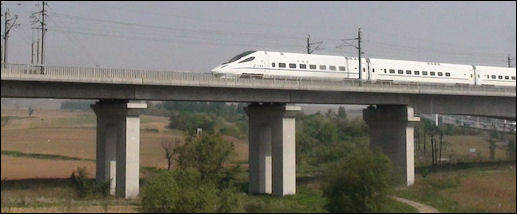
The deadly train accident in Wenzhou in eastern China in July 2011 only added to a national sense of unease that safety may have been sacrificed in the country’s rush to modernize ( See Wenzhou Train Crash). After the Wenzhou train crash an editorial with the headline “No Development Without Safety” on People’s Net, the government-run Web site affiliated with the party’s leading newspaper, People’s Daily, pointed out the widespread public dissatisfaction over safety. “From public transport safety to coal mine safety to food safety, these accidents show that theoretically there is no problem with the conception of safety plans,” the influential site said. “But they are not executed properly.”
300-Meter-Long Rail Section Near Yangtze River Collapses
In March 2012, AP reported: “Part of a high-speed railway line that had already undergone test runs collapsed in central China following heavy rains, state media reported Monday, jolting railroad shares and reviving worries over safety. Xinhua other reports said a 300-meter (984 feet) section of the railway line had collapsed, but mentioned no casualties or other details. It said hundreds of workers were rushing to repair the line between the Yangtze River cities of Wuhan and Yichang. The railway line is due to open in May. [Source: Elaine Kurtenbach, AP, March 12, 2012]
The reports of the accident Friday near Qianjiang city in Hubei province, the latest since a bullet-train crash last summer that killed 40 people, rattled share markets in Hong Kong and Shanghai, where major railway company stocks dropped on the news. China Railway Construction Corp. dropped 6.6 percent, China Railway Group Ltd. fell 5.7 percent to HK$2.82 and China Southern Rail lost 4.4 percent. All are traded in Hong Kong.
China has massive resources and considerable prestige invested in its showcase high-speed railways program, and the news appeared to raise sensitivities over the issue. A local government website ran an article denying that any collapse had occurred. An officer who answered the phone Monday in the information office of the China Railway 12th Bureau Group Co., which is in charge of the project, said he had not heard about the collapse and said no other officials were available for comment. The official refused to give his name or title.
Corruption and China’s High-Speed Trains
The huge amounts of spending and debt connected with high-speed rail construction was partly blamed for corruption. In March, the National Audit Office said it had identified $800 million of financial irregularities in the Beijing-Shanghai link alone.
Evan Osnos wrote in The New Yorker: “China’s most famous public-works project was an ecosystem almost perfectly hospitable to corruption—opaque, unsupervised, and overflowing with cash, especially after the government announced a stimulus to mitigate the effects of the 2008 global financial crisis. It boosted funding for railway projects to more than a hundred billion dollars in 2010. In some cases, the bidding period was truncated from five days to thirteen hours. In others, the bids were mere theatre, because construction had already begun. Cash was known to vanish: in one instance, seventy-eight million dollars that had been set aside to compensate people whose homes had been demolished to make way for railroad tracks disappeared. Middlemen expected cuts of between one and six per cent. “If a project is four and a half billion, the middleman is taking home two hundred million,” Wang said. “And, of course, nobody says a word.” [Source: Evan Osnos, The New Yorker, October 22, 2013]
“One of the most common rackets was illegal subcontracting. A single contract could be divvied up and sold for kickbacks, then sold again and again, until it reached the bottom of a food chain of labor, where the workers were cheap and unskilled. (The practice is hardly unique to the railways: in 2010, a rookie welder employed by an illegal subcontractor was working on a dormitory in Shanghai when he dropped his torch and set the building on fire; fifty-eight people died.) In November, 2011, a former cook with no engineering experience was found to be building a high-speed railway bridge using a crew of unskilled migrant laborers who substituted crushed stones for cement in the foundation. In railway circles, the practice of substituting cheap materials for real ones was common enough to rate its own expression: touliang huanzhu—robbing the beams to put in the pillars.
“With so many kickbacks changing hands, it isn’t surprising that parts of the railway went wildly over budget. A station in Guangzhou slated to be built for three hundred and sixteen million dollars ended up costing seven times that. The ministry was so large that bureaucrats would create fictional departments and run up expenses for them. Procurement was a prime opportunity for graft. The ministry spent nearly three million dollars on a five-minute promotional video that went largely unseen. The video led investigators to the ministry’s deputy propaganda chief, a woman whose home contained a million and a half dollars in cash and the deeds to nine houses; her husband, who also worked for the ministry, was found to have a collection of gift cards—a discreet alternative to cash bribes. Other government agencies also had serious financial problems—out of fifty, auditors found problems with forty-nine—but the scale of plunder in the railway world was in a class by itself. Liao Ran, an Asia specialist at Transparency International, told the International Herald Tribune that China’s high-speed railway was shaping up to be “the biggest single financial scandal not just in China, but perhaps in the world.”
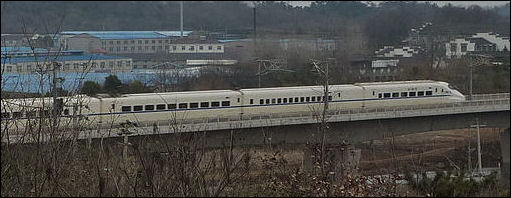
China’s High-Speed Trains, Corruption and Safety
Chinese and foreign engineers have questioned the long-term strength of the concrete used in bridges and viaducts under contracts awarded during the term of the disgraced former rail minister, Liu Zhijun.
The high cost of some segments of the high-speed railway system in Shanxi Province have been linked to corruption. Keith B. Richburg wrote in the Washington Post, “After the railway official, Liu Zhijun, was detained by the Communist Party’s disciplinary committee, stories began trickling out about how a businesswoman in Shanxi province set up an investment company that took kickbacks from firms awarded contracts on the project.” [Source: Keith B. Richburg, Washington Post April 23, 2011]
“In March, government auditors found several problems with the construction of the Beijing-to-Shanghai line, including fake invoices that more than a dozen companies used for construction materials and supervisors at some construction companies who lacked professional engineering licenses. The revelations have led to questions about safety and whether corrupt subcontractors cut corners to line their pockets.”
There are worries about the quality of the high-speed railways in connection with the Liu and Zhang scandal. Chinese media have reported Liu and Zhang gave some purchase orders or construction contracts to companies based on the bribes they would receive, rather than on the firms' reputations. Substandard construction is risky on tracks supporting a train that travels at 250 kilometers per hour.
Complaints by Passengers and Resident About the High-Speed Trains

Some of longer routes already draw much heavier ridership. The trains, which typically carry 600 passengers, sometimes sell out despite departures every 10 or 15 minutes, particularly on Fridays but sometimes even at lunchtime in the middle of the week. Of course, high speed is relative. First, a passenger must actually get a seat. [Source: Keith Bradsher, New York Times June 22, 2011]
Zhou Junde, a migrant construction worker, told the New York Times while he stood in line at the Changsha station in Hunan Province to buy a high-speed ticket to Guangzhou the next high-speed train was sold out, and so was the next one 10 minutes after that. He would have to wait 30 minutes to board a train with a seat. “Sometimes,” he said, “I come several hours early to get the departure I want.”
The steep prices for high-speed train tickets have touched China’s raw nerve of rising income inequality. “The government is just abusing the money of the common people,” said one posting on an Internet quoted by the New York Times. From Changsha to Guangzhou, the one-way fare in economy class for the two-hour journey, at speeds of up to 210 miles per hour, is 333 renminbi ($51). That is comparable to a deeply discounted airfare, but expensive for a migrant worker from Hunan who might earn only $160 to $400 a month in wages in Guangzhou. The same trip takes nine hours on an older, diesel train. But it costs only 99 renminbi ($15). [Source: Keith Bradsher, New York Times June 22, 2011]
According to The Daily Beast: An uptick in the feistiness of civil society has triggered a number of questions and complaints from ordinary citizens about high-speed rail projects. Residents in some Beijing communities raised objections to a new high-speed rail project, due to begin construction in June, that will link Beijing and the northern city of Shenyang. The residents are jittery about safety and noise; in December 2012, about 300 protested to ask the government to change the proposed route. The critics also complained that an environmental impact assessment published online was wrong to state that almost 40 percent of residents surveyed had expressed approval of the route. The Railways Ministry responded in a statement, “Construction of the Beijing-Shenyang rail line will not begin unless a solution can be agreed on by most of the residents.” [Source: Melinda Liu, Daily Beast, January 5, 2013]
Reducing the Speed of the High-Speed Trains and Slowing the Pace of Construction
In April 2011, the new railways minister, Sheng Guangzu , said he would be putting the brakes not only on the pace of construction — slashing the budget for new rail projects to 2.8 trillion yuan over the period to 2015 — but on the actual speed of the trains.
It was originally intended that trains on the Beijing-Shanghai route would complete the 1,318-kilometre journey in less than four hours, with trains running at speeds of 350 kilometres per hour or more. Instead, trains will run at maximum speeds of either 300km/h or 250km/h, adding at least an hour to the trip. Although ministry officials have insisted this is increase energy efficiency and allow for tickets to be more affordable, there have been widespread suggestions it was prompted by safety fears.
Beijing and Shanghai made their passenger, extending China's high-speed rail network to nearly 10,000 km.
High-Speed Trains, Controversial Patents and Technology Transfers
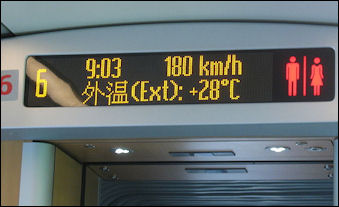
China's trains are based on Japanese, French and German technology but its manufacturers are trying to sell to Latin America and the Middle East. That has prompted complaints Beijing is violating the spirit of licenses with foreign providers by reselling technology that was meant to be used only in China.
The Chinese claim they spent considerable time and effort improving the railway technology they picked up from abroad. Sun Zhang of Tongji University, told the Global Times that China spent six or seven years developing and upgrading high-speed railway technology imported from abroad. The country also made breakthroughs independently in many areas such as increasing cruising speed and enlarging carriage space. [Source: Liu Linlin and Zou Le, Global Times, December 8, 2010]
Therefore, Sun said, China's railway technologies have emerged from its own intellectual property rights, which shall not bother China's exports of its expertise, he said. "China's railway industry produced this new generation of high-speed train sets by learning and systematically compiling and re-innovating foreign high-speed train technology," the Railways Ministry said in November, according to a Wall Street Journal report.
Beijing has long pushed for technology transfer in fields from high-speed rail to clean energy as a condition of contracts or licenses. China's bullet trains are based on European and Japanese technology but are being marketed in Latin America and the Middle East, prompting complaints it is violating the spirit of such agreements.
After sharing technology and expertise to help China develop a network of gleaming bullet trains, Japanese and European rail firms now find themselves competing with their former Chinese joint-venture partners for new contracts, both inside and outside China. China has joined overseas projects based on high-speed railway technology introduced from Japan, Germany and other nations.
In June 2011, China took out patents for its rapid-transit railway technology in places including Japan and Europe with technology that clearly had been borrowed form Japan and Europe. According to a high-ranking Chinese government official, quoted in the China daily, China is applying for 21 patents in Japan, the United States, Brazil, Russia and Europe, including ones concerning train car hulls and bogies. Of the 21, eight have already passed preliminary screenings, the official was quoted as saying. The Chinese government has said its high-speed rail technology was developed completely on its own, with an official at the Railways Ministry saying, "We adopted it [the technology from overseas], digested it, absorbed it and innovated based on it." [Source: Yasushi Kouchi, Yomiuri Shimbun, June 29, 2011]
Under the licensing agreements with companies in Japan, Germany, France and Canada, China's use of the expertise to develope high-speed railway cars was to be limited to domestic application. Kazuki Nishihara and Yasushi Kouchi wrote in the Japan newspaper Yomiuri Shimbun, “Business circles in Japan are increasingly alarmed by China's efforts to export high-speed railway trains it claims to have built through its own expertise — but which have obviously been duplicated from technology offered by Japan.” [Source: Kazuki Nishihara and Yasushi Kouchi, Yomiuri Shimbun, June 30, 2011]
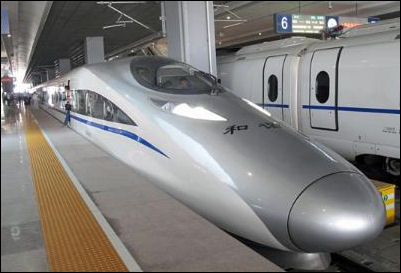
“In 2004 and 2005, Kawasaki Heavy Industries Ltd., five other domestic companies and a Chinese firm jointly produced 960 train cars for 120 trains modeled on Japan's Hayate bullet train, and supplied them to China. These supplied trains and the version China has filed patents for bear a striking resemblance. Technology provided as a token of friendship is now leaving a sour taste in the mouths of some government officials. "[Japanese] people involved in the project feel rather unhappy about this. China copied the technology of the supplied cars and claims it as original technology," a Land, Infrastructure, Transport and Tourism Ministry official said bitterly.” Japanese companies are calmly watching the matter — at least outwardly. China is an important market for manufacturers of train components and they do not want to cause trouble.
Leo Lewis wrote in the Times of London, “Siemens and Kawasaki, both muttering about stolen technology, were fuming as the bullet train slid out of Beijing to claims that it was fundamentally Made in China. Sources at the Japanese Ministry for Economy, Trade and Industry told The Times that it would look carefully at any contract won by China in Europe or the US, jurisdictions where Japanese companies could more effectively sue for intellectual property infringement. [Source: Leo Lewis, Times of London, June 28, 2011]
Zhou Yimin , a retired deputy chief engineer and head of China’s railway ministry's science and technology department, said that virtually all key components in the trains were still supplied by overseas firms. "Key equipment was all made by foreign companies such as Siemens," Zhou said. "Though the manufacturing capabilities of the rail industry have improved a lot with the introduction of overseas prototypes in recent years, China's [research and development] remains peripheral...Our trains look almost exactly the same as their peers overseas."
Image Sources:
Text Sources: New York Times, Washington Post, Los Angeles Times, Times of London, The Guardian, National Geographic, The New Yorker, Time, Newsweek, Reuters, AP, Lonely Planet Guides, Compton’s Encyclopedia and various books and other publications.
Last updated July 2022

